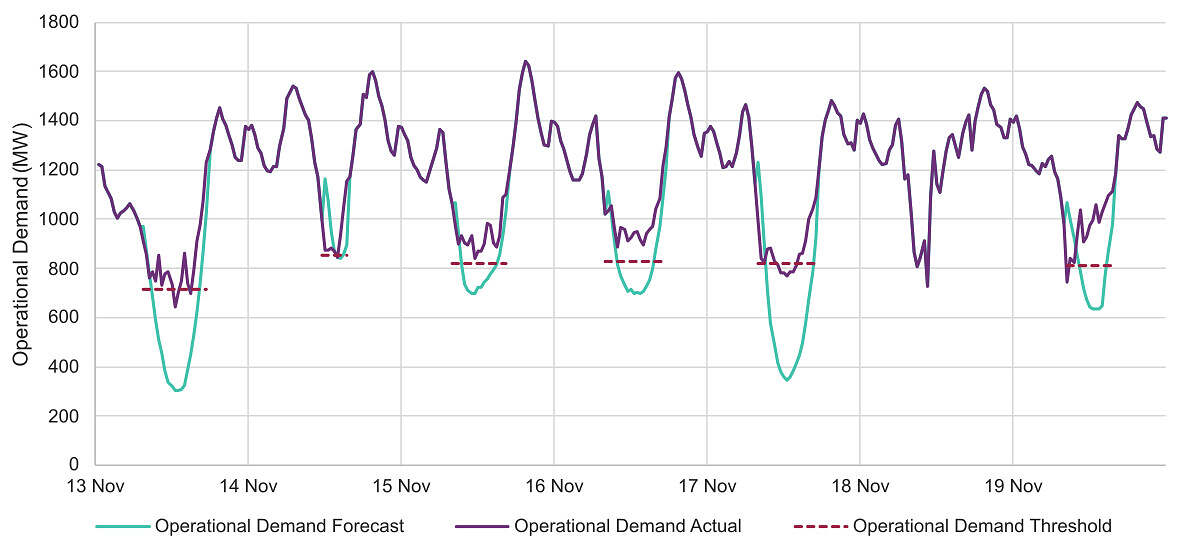With nearly 350,000 households in South Australia (>37%) now having rooftop solar, the distribution network operated by SA Power Networks has become a major source of energy generation. In fact, at times there is significantly more solar generation capacity on household rooves than demand, exporting at times almost 400MW into the transmission system. This is a result of being the first GW scale grid in the world to have operational demand met by up to 100% rooftop solar.
Most of the time SA has a secure electricity supply, but system security becomes more challenging to manage in SA when the Heywood interconnector to Victoria is lost and the State’s energy system becomes “islanded”. These are rare events but require careful management to ensure energy supply stability.
If islanded during a non-credible contingency event, the national market operator AEMO must source all frequency control resources from within the SA energy island in addition to directing scheduled units to maintain minimum levels of system strength.
When these methods are unable to provide sufficient contingency, AEMO will direct SA Power Networks to increase electricity demand by curtailing solar.
During November 2022, this type of intervention was required to keep the SA grid stable due to the loss of the only AC interconnection to Victoria for nearly a week when a transmission tower was taken out by a severe storm event.

Image: ElectraNet
During this week, variable renewable energy generation peaked at just over 91% while islanded, helping further push the boundaries of operating a power system at very high levels of variable renewable energy.
Based on AEMO’s forecasts, the safe operating minimum operational demand threshold would have been exceeded most days during the outage without intervention to curtail solar. Our response as a Distribution System Operator is shown by the actual operational demand through the active curtailment of distribution connected solar.

Image: AEMO
Historically SA Power Networks has managed the curtailment of solar in three ways:
- instructing large SCADA connected solar generators directly connected to the distribution network to turn off;
- instructing remote disconnection of rooftop solar covered by the SA Government’s Relevant Agent arrangements (applies to new solar installations since September 2020); and, if needed,
- increasing voltage in targeted substations to trip off a proportion of older solar systems.
Whilst these mechanisms have helped keep the lights on in extreme circumstances, they can be blunt instruments. Some of the methods above don’t support export limiting which means the customer cannot self-consume solar during an emergency. They also may limit the ability of other types of behind the meter resources, such as home batteries, to assist during the event by charging, or even providing FCAS.
There is a better option to integrate these resources into the network in a more harmonious way. SA Power Networks has developed its exciting Flexible Exports option, which in the long run, will provide a smart way to manage the bidirectional flow of energy in the distribution network.
After market signals and other mechanisms such as time of use tariffs have optimised energy flows, Flexible Exports provides the guardrails to ensure the network stays within its limit. This is achieved with the use of Dynamic Operating Envelopes, regularly published to the site over the internet.
In addition to providing a greater access to exports for customers all year round, Flexible Exports can also fill the role of an emergency backstop lever using the same communications pathway. Although events requiring emergency intervention are rare, customers will be able to benefit from self-consumption when using the Flexible Exports solution.
Much in the same way that having brakes on a car allows you to drive faster, having smart solar allows for a much higher penetration of renewable energy onto the grid.
There are other measures being introduced to manage system security risks presented by rooftop solar. SA Power Networks is proactively working with industry to make sure new solar inverters are set up with the right settings to ride through transmission faults. The new SA/NSW transmission interconnector (Project Energy Connect), planned for completion in 2026, will also reduce the likelihood of having to use emergency backstops.
The introduction of the Flexible Exports option means we can support significantly more solar exports on our network. Whilst also exploring more ways to store or match loads with excess renewable generation, curtailment will be a key feature of a high variable renewable energy power system. At rare times when things go wrong, Dynamic Operating Envelopes can help keep the lights on.
About our Guest Author
 |
Blake Ashton is a Strategy Lead at SA Power Networks. As part of the Network Strategy team, Blake is responsible for the delivery of new advanced technology systems required to successfully transition SA Power Networks into the new energy future. At the SA Power Networks Network Innovation Centre, Blake has supported the successful delivery of key pilots and trials, such as Flexible Exports, focussed on enabling the successful integration of distributed energy resources into the SA distribution network.
You can find Blake on LinkedIn here. |


Be the first to comment on "SA Islanding: Managing solar on the island"